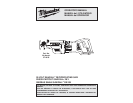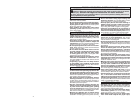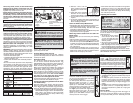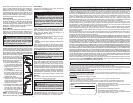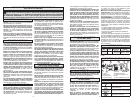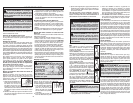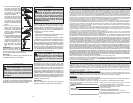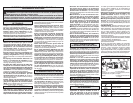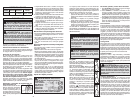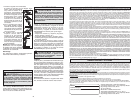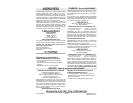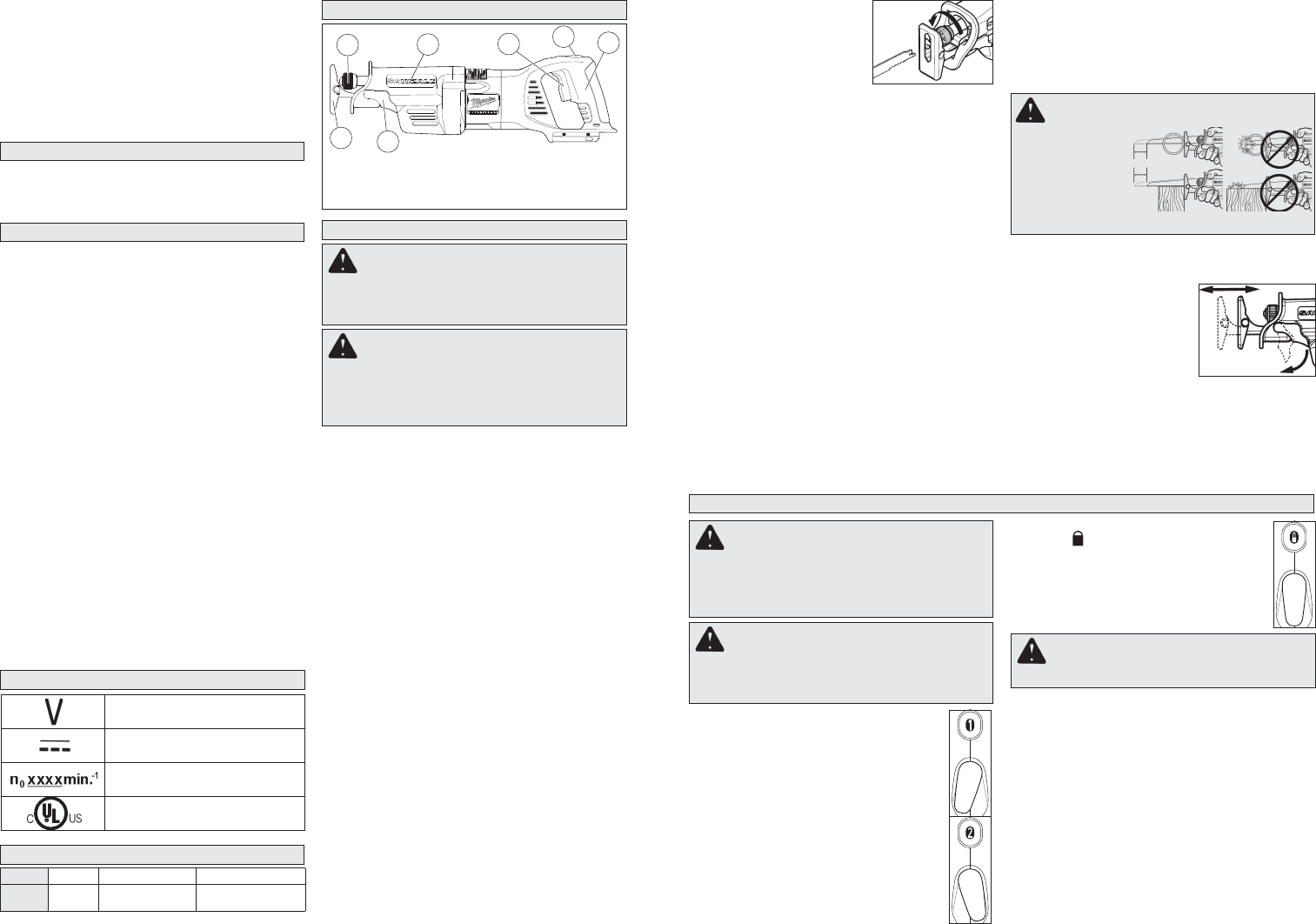
4
5
FUNCTIONAL DESCRIPTION
SYMBOLOGY
SPECIFICATIONS
Cat. No.Volts DCLength of StrokeStrokes per Minute
0719-20 28 1-1/8" Hi 0 - 3000
Lo 0 - 2000
• Hold power tool by insulated gripping sur-
faces, when performing an operation where the
cutting accessory may contact hidden wiring.
Cutting accessory contacting a “live” wire may
make exposed metal parts of the power tool “live”
and could give the operator an electric shock.
• Use clamps or another practical way to secure
and support the workpiece to a stable platform.
Holding the work by hand or against your body
leaves it unstable and may lead to loss of control.
• Maintain labels and nameplates. These carry
important information. If unreadable or missing,
contact a MILWAUKEE service facility for a free
replacement.
• WARNING: Some dust created by power sanding,
sawing, grinding, drilling, and other construction
activities contains chemicals known to cause can-
cer, birth defects or other reproductive harm. Some
examples of these chemicals are:
• lead from lead-based paint
• crystalline silica from bricks and cement and other
masonry products, and
• arsenic and chromium from chemically-treated
lumber.
Your risk from these exposures varies, depending
on how often you do this type of work. To reduce
your exposure to these chemicals: work in a well
ventilated area, and work with approved safety
equipment, such as those dust masks that are
specially designed to fi lter out microscopic particles.
1. Handle
2. High/Low/Trigger lock
switch
3. Trigger
7
6
5
4
3
1
2
4. Insulating boot
5. Quik-Lok™ blade clamp
6. Shoe
7. Shoe release lever
ASSEMBLY
WARNING Recharge only with the
charger specified for the battery. For spe-
cifi c charging instructions, read the operator’s
manual supplied with your charger and battery.
Removing Battery Pack from Tool
Push in the release buttons and pull the battery
pack away from the tool.
Inserting Battery Pack into Tool
To insert the battery pack onto the tool, slide the
pack onto the body of the tool. Make sure it latches
securely into place.
Selecting a Blade
The Quik-Lok
®
Blade Clamp can be used with
all 1/2" shank universal Sawzall
®
blades. Use
MILWAUKEE High Performance Super Sawzall
®
blades for best performance. When selecting a
blade, choose the right type and length.
Many types of blades are available for a variety of
applications: cutting metal, wood, nail-embedded
wood, scroll cutting, roughing-in, and contours.
Many lengths are also available. Choose a length
long enough to extend beyond the shoe and your
work throughout the stroke. Do not use blades
less than 3-1/2" long since they won't extend
beyond the shoe throughout the stroke.
For best performance and longest life, see “Acces-
sories” to select the best blade for the job.
Installing and Removing Blades from the Quik-
Lok
®
Blade Clamp
Remove battery pack before changing blades.
Make sure the spindle and blade clamp areas are
clean. Metal chips and sawdust may prevent the
Quik-Lok
®
Blade Clamp from clamping securely.
1. Depending on the job, the blade may be inserted
with the teeth facing up or down. To install a blade,
twist collar in the direction of the arrow while
inserting the blade into the clamp until the tang
butts against the collar.
WARNING Always remove battery
pack before changing or removing ac-
cessories. Only use accessories specifi cally
recommended for this tool. Others may be
hazardous.
Use only MILWAUKEE M28™ or V28
®
battery packs.
OPERATION
WARNING Alwa
ys remo
ve battery-
pack before changing or removing acces-
sories. Only use accessories specifically
recommended for this tool. Others may be
ha
zardous.
1/4 Turn
2.
Release collar and the
spring loaded mechanism
will clamp the blade fi rmly
in place.
3. Twist collar in the opposite
direction of the arrow to
ensure that the blade is locked into the clamp.
4. Tug on blade to make sure it is securely locked
in place.
5. To remove a blade, twist collar in the direction of
the arrow while pulling on the blade. Be careful
when handling hot blades.
Quik-Lok
®
Blade Clamp Maintenance
• Periodically clean dust and debris from the Quik-
Lok
®
Blade Clamp with dry compressed air.
• If the collar resists twisting, twist the collar back
and forth to shake debris loose.
• Periodically lubricate Quik-Lok
®
Blade Clamp with
a dry lubricant such as graphite.
Removing broken blades from the Quik-Lok
®
Blade Clamp
Broken blades can be removed by the following
methods.
• Remove battery pack before removing blades.
• Point the tool downward, twist the collar, and
shake the tool up and down (DO NOT turn the tool
on while your fi ngers are holding the blade clamp
open). The shank of the broken blade should drop
out of the clamp.
• If shaking the tool doesn't work, in most cases, a
corner of the broken blade will extend beyond the
blade clamp. Twist the collar and pull the broken
blade out of the clamp by this corner.
WARNING To reduce the risk of injury,
keep hands away from the blade and all
moving parts. Always wear safety goggles or
glasses with side shields.
High/Low/Trigger Lock Switch
To set the maximum speed or lock the trig-
ger, move the high/low/trigger lock switch
to the following positions:
For low speed (Maximum 2000 RPM):
Move the switch to the left."
1
" will be
displayed above the switch. To vary the
speed up to 2000 RPM, increase or de-
crease pressure on the trigger. Low speed
is generally used for cutting metals.
For high speed (Maximum 3000 RPM):
Move the switch to the right. "
2
" will be
displayed above the switch. To vary the
speed up to 3000 RPM, increase or de-
crease pressure on the trigger.
WARNING To reduce the risk of
injury, blades
must extend
beyond the shoe
and workpiece
throughout the
stroke. Blades
may shatter if they impact the workpiece or shoe.
• If the broken stub doesn't extend far enough to be
grabbed by its corner, use a thin blade with small
teeth (such as a metal cutting blade) to hook the
blade that is jammed in the clamp while twisting
the collar and pull it out.
Adjusting the Pivot Shoe
The shoe can be adjusted forward or backward to
six positions to take advantage of the unused por-
tion of the blade or for special jobs requiring low
blade clearance.
1. To adjust the shoe, pull the
shoe release lever down
1/4 turn and slide the shoe
forward or backward to the
desired position.
2. To lock the shoe in position,
push the shoe release lever up.
3. After adjusting the shoe, slowly pull the trigger to
be sure the blade always extends beyond the shoe
and your workpiece throughout the stroke.
DO NOT OPERATE SAWZALL WITHOUT SHOE.
STRIKING THE SPINDLE AGAINST WORKPIECE
MAY DAMAGE THE TOOL.
To lock the trigger: Move the switch to the
center. "
" will be displayed above the
switch. The trigger will not work while the
switch is in the locked position. Always lock
the trigger and remove the battery pack be-
fore performing maintenance and changing
accessories. Lock the trigger when storing
the tool and when the tool is not in use.
stroke
SPECIFIC SAFETY RULES
SERVICE
Volts
Direct Current
No Load Strokes per Minute
(SPM)
Underwriters Laboratories, Inc.
United States and Canada
coins, keys, nails, screws, or other small metal
objects that can make a connection from one
terminal to another. Shorting the battery terminals
together may cause burns or a fi re.
• Under abusive conditions, liquid may be eject-
ed from the battery; avoid contact. If contact
accidentally occurs, fl ush with water. If liquid
contacts eyes, additionally seek medical help.
Liquid ejected from the battery may cause irritation
or burns.
• Have your power tool serviced by a qualifi ed
repair person using only identical replacement
parts. This will ensure that the safety of the power
tool is maintained.
WARNING To reduce the risk of per-
sonal injury, always hold tool securely.
Starting, Stopping and Controlling Speed
1. To start the tool, grasp the handle fi rmly and pull
the trigger.
2. To vary the speed, increase or decrease the
pressure on the trigger. The further the trigger
is pulled, the greater the speed. The maximum
RPM is determined by the high/low/trigger lock
switch.
3. To stop the tool, release the trigger. Make sure
the blade comes to a complete stop before re-
moving the blade from a partial cut or laying the
tool down.
Electric Brake
The electric brake engages when the trigger is
released, causing the blade to stop and allowing
you to proceed with your work. Generally, the saw



